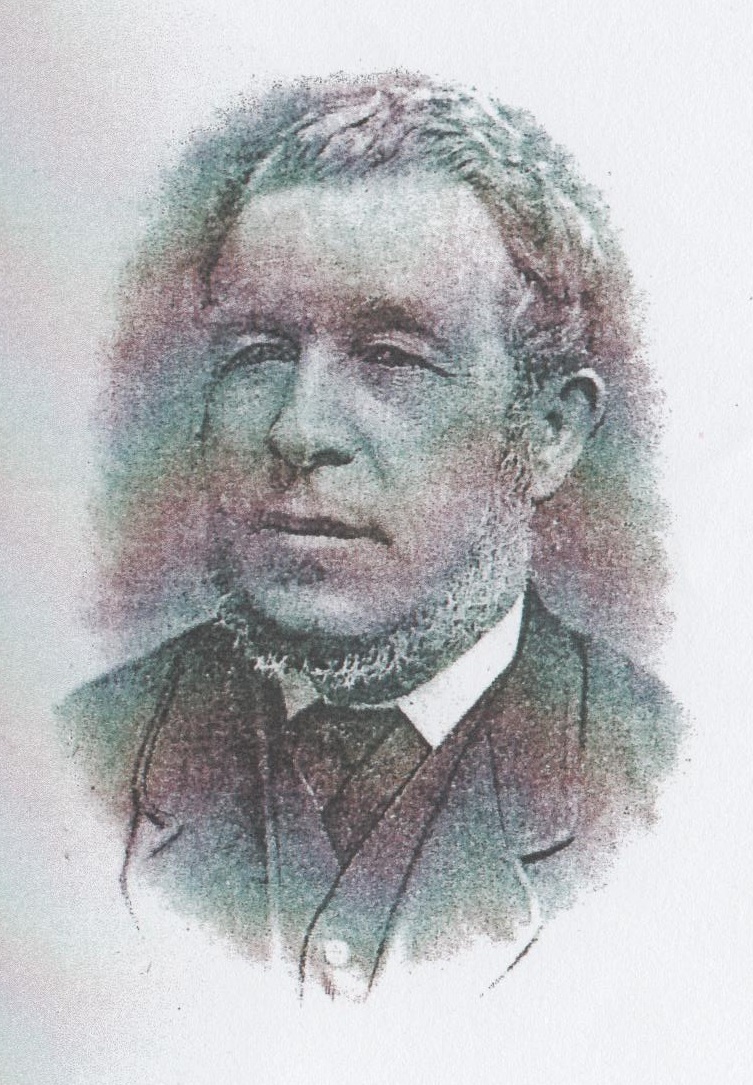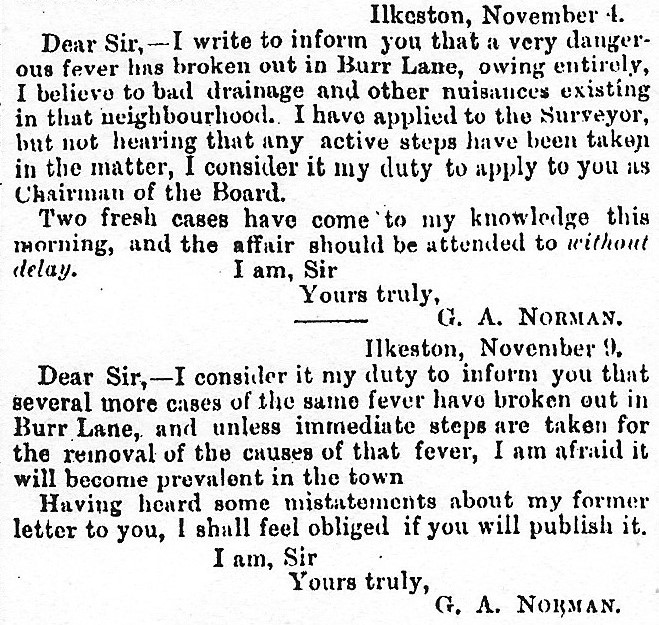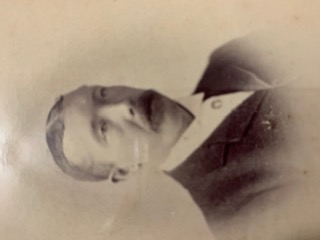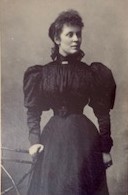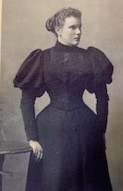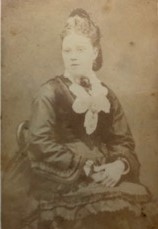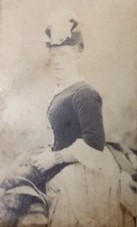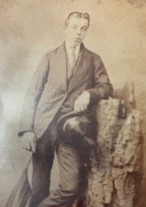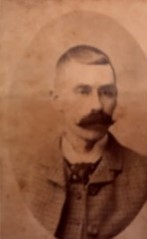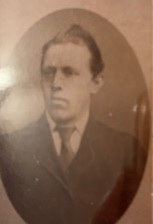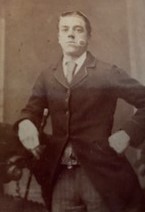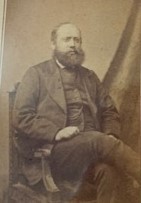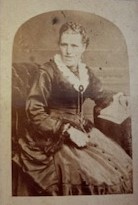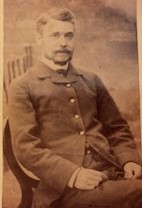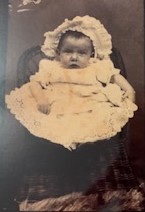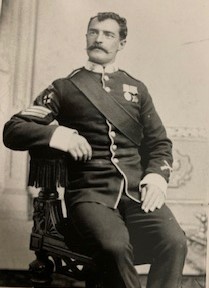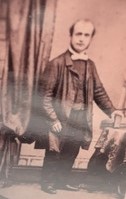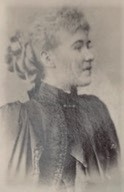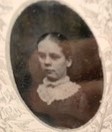Near the top end Adeline recalls that “the next shop was Mr. Solomon Beardsley’s bread and confectionery shop. He built a bakehouse at the rear.” In 1871 and 1881 this was 5 Bath Street. About 1887 the Bath Street premises were renumbered; now this side of the street had only odd numbers and the Beardsley property was now number 7.
——————————————————————————————————-
A brief background
One of at least 12 children, Solomon Beardsley was born on October 28th 1831, the third son of John, grocer/baker and draper of Bath Street, and Catherine (nee Skevington)…. ‘Solomon‘ was the name of his paternal grandfather.
Adeline recalls that “his first wife died leaving him with four children”; she was Eliza Mellor, youngest of the ten children of William, lacemaker of Anchor Row, and Rhoda (nee Palmer). They married on July 5th, 1851. Eliza died on December 14th 1858, aged 29, four days after the birth of their fifth child, William.
Adeline continues :“Mr. S. Beardsley’s second wife was Miss Sudbury, who had lived with her mother in Anchor Row.”
Perhaps the responsibility of raising four young children (one had died) without a wife led Solomon to marry again, on July 5th 1859, only a few months after Eliza’s death.
His second wife was Matilda Potter Sudbury, living in Anchor Row with her unmarried mother Hannah and uncle Alfred, lace manufacturer — both children of stockingweaver William and Sarah (nee Thompson).
Miss-counting, Adeline states that “they had one little daughter, Annie Maria.”
In fact five children followed Solomon’s second marriage …Hannah Maria who died on April 21st 1875 in her fifteenth year; Henry who died in June 1863, aged five months; Frank who died on March 1st 1883, aged 18; Matilda who died on August 28th 1880, aged 12; Harry who died in infancy, on November 23rd 1870.
All were buried in Stanton Road Cemetery.
It was about 1887 that Solomon and his family moved into Holmfield House in St. Mary Street. By this time Solomon had served for several years on the Local Board and in 1887 he secured election to the first Town Council, for the Central Ward, but didn’t seek re-election when his term ended in 1890. In politics he served as a Liberal, while in religion he was a member of the Independent (Congregational) Church — his younger son William was organist there.
In early 1892 Solomon’s partnership with William Pounder — trading as Beardsley and Pounder, brickmakers of Rutland Wharf and Gallows Inn — was dissolved.
Solomon died at his home on April 22nd, 1895 and was buried at Ilkeston General Cemetery in Stanton Road. The funeral was ‘quietly and unostentatiously‘ organised by John Carrier of Bath Street who was married to Solomon’s niece, Sarah Beardsley (the illegitimate daughter of Mary). The coffin was of polished oak, with brass fittings, the breast plate bearing his name, date of birth and age, and was made by another, more distant relative, Francis Herbert Goddard of 11 East Street. Because of Solomon’s membership of the Rutland Lodge of Freemasons, about 20 of hs fellow members were in the funeral cortege and, at the cemetery, performed their parting salute and threw sprigs of acacia upon the coffin.
Solomon’s wife Matilda died at the Bath Street home of her step-son John Beardsley on November 12th, 1901.
——————————————————————————————————-
1866: Ilkeston ‘peppered’ with a rash of infectious thefts
Solomon had established himself in Bath Street as a grocer and baker in 1857. To reach the back kitchen of his premises from Bath Street an open and exposed yard had to be crossed. This, however, did not deter Robert Pepper.
In late March of 1866 he paid an uninvited and unwelcome clandestine night-time visit to this kitchen and left shortly afterwards with two brushes, a towel, a looking-glass, a basket, boots and a cap — the property of Solomon and his apprentice John Hind — while the house occupants slept soundly in their beds.
About a week later Robert’s wife Mary took the boots to pawnbroker John Moss and pledged them with him for 4s 6d. Almost immediately John passed them over to Inspector Brady and just as speedily the Inspector called on the Peppers, taking them both into custody.
A week before the theft from Solomon’s kitchen, Robert had made a similar visit to the home of coalminer Samuel and Esther Riley in New Street. That time he left with an iron pot, an iron saucepan, and a coal pick — all these items were reclaimed by the Inspector from the Pepper’s home when he arrested the couple, and later identified by Esther Riley.
Robert was eventually prepared to ‘take the rap’ for the theft of all this ‘loot’ — his wife was ‘as innocent as a baby’ he claimed. He was believed and so Mary was released.
Also recovered from the Pepper house at the same time were another towel, aprons, shoe brushes, a zinc bucket and a couple of wooden buckets, a mop, an iron kettle, a water jug and a pie dish — all ‘missing’ from premises close to those of baker Solomon and coalminer Samuel.
After an appearance at the Petty Sessions on the same day as his arrest, Robert was committed for trial at the next Quarter Sessions. The period from his arrest to his remand was less than half a day.
As you may have guessed from the number of Robert’s ill-gotten articles in his possession, he was not a stranger to criminal activity.
At his appearance at the Derby Assizes in July — where he pleaded guilty to the thefts — it was revealed that Robert had been convicted for similar offences several times before, and had twice been sentenced to penal servitude for four years.
Robert was born in Nottingham in 1840, and worked with his father, Robert senior, as a chimney sweep — it was helpful to the ‘family business’ that he was just over five feet tall.
In 1854 he stole a pair of trousers and found himself in prison for six weeks; in 1855 he stole a shirt for which crime he received two months in prison — both convictions under the Juvenile Offenders Act 1847 (amended 1850).
At the age of 16 — and thus no longer subject to the above Act — he was convicted of stealing a watch and sentenced to four years penal servitude. He was released in October 1859, but a year later was back inside, serving another four year sentence of penal servitude for larceny. He was released on license from Dartmoor Prison in January 1864.
Between the time of this release and committing the spate of robberies in Ilkeston, Robert found the time to get married, at Ilkeston Independent Chapel, to Mary Freeman alias Fish, illegitimate daughter of Sarah Freeman (who later married William Fish).
Perhaps he soon tired of married life, or it did not live up to his expectations, or perhaps he was a compulsive thief ? … for whatever reason, within a year Robert was facing another period in prison.
For his Ilkeston robberies he was sentenced to seven years penal servitude, towards the end of which, in February 1872, he was again released on license.
Robert was the uncle of Mary Ann Pepper who, as a child living in Albion Place, experienced a very traumatic event in her life.
——————————————————————————————————-
Solomon the ‘animal-lover’ (?) … Part 1
Solomon was not simply a baker .. he later kept cows, dealt in corn and operated a brick-making works at Rutland Wharf with William Pounder.
He also kept three pigs in a stye in Burr Lane which drew complaints from neighbours. The Local Board investigated this and found them ‘in tolerable condition’.
Some time after this, in November 1869, Dr. George Allen Norman visited the area and had detected a dangerous fever there. The neighbouring Gladstone Inn had no adequate drainage, there were no means of draining the cesspools, and privies at the rear of the premises — everything drained into a large stagnant cesspool. And Solomon’s piggery was now a cause of significant concern; his drift now numbered “14 or 15 pigs, and a great quantity of manure in a most offensive state, and emitting a most offensive effluvia in the neighbourhood”.
The Board now found them in an intolerable condition!!
Dr. Norman pressed his case for the Board to act and fired off a couple of letters (right).
He wanted the Inn to drain its premises to the main sewer, which the Board complied with. And he wanted removal of the piggeries.
Solomon was not impressed.
“I don’t know this Board has owt to do wi’ publishing his letters — let him publish them his sen”.
Despite his protestations, Solomon was served with an order to remove manure at the corner of Burr Lane and to discontinue keeping pigs there. The Pioneer gleefully and rather mischievously reported at length the Board’s discussions subsequent to this order and Solomon’s unsuccessful defence of his pigs and their habitat.
“Where does my nuisance spring from?” asked Solomon. ‘The neighbours say it doesna spring from the pigstees. I’ve bin an’ seen them, an’ they complain only o’ th’ privies. I’ve only three or four pigs there: don’t think there’s six.’
And of the manure, he confessed ‘I’ve bin so busy, or else it would a’ bin shifted afore’.
This was at the time of the feud between some Liberal members of the Local Board and Conservative John Wombell of the Ilkeston Pioneer. (See The 1869 Election Crisis).
By reporting Solomon’s remarks in his ‘Derbyshire vernacular’ the newspaper was, in the opinion of Board member, Radical Liberal and Market Place draper William Smith, “calculated to bring contempt and ridicule on Mr. Beardsley and the proceedings of the Board, and the Board ought not to submit to such an indignity”.
Consequently it was resolved that “while we wish to give publicity to the business transacted at this Board, we repudiate such reports as have recently appeared in the Pioneer newspaper; and it is agreed, that should similar reports appear in future, the reporter so committing himself be prohibited from attending the Board meetings”.
Solomon the ‘animal-lover’ (?) … Part 2
In July 1870, in the Nottinghamshire Guardian…
Nine months later, at the 1871 census, it appears that John Briggs may have responded to Solomon’s ‘ad’ … he was then the 15 year-old assistant baker living with his master. His parents, watchmaker William and Mary (nee Barlow), were not far away … in South Street.
In 1871 Solomon lost his horse in a severe thunderstorm when the animal was struck by a vivid flash of lightning and died immediately. Again, gossip was spread. There were subsequent rumours that the baker had worked the animal to death and so an autopsy was performed by Samuel Revill, veterinary surgeon.
His report stated “I noticed particularly the heart, and found it quite sound and perfectly healthy and free from any symptoms of rupture. I have no hesitation in saying that the horse died from the effects of lightning”.It might be noted that, at this time the ‘vet’ was Solomon’s next door neighbour !!
During the same storm several people testified to seeing a ball of fire rolling along South Street into the Market Place where it exploded harmlessly.
——————————————————————————————————-
1870s: Trouble with loaves
The Pioneer was often very harsh upon Solomon.
For example, under the heading of ‘The “Wise” Baker Again’, the newspaper reported upon his appearance at Ilkeston Petty Sessions in December 1874. He was accused of refusing to weigh bread in the presence of a purchaser and with selling an unweighed loaf which was half an ounce underweight.
The total cost to Solomon of these misdemeanours was £5 9s.
Not the first time for Solomon !! A couple of months before, the baker had been making deliveries at Stanton by Dale and didn’t have a correct beam and scales with him so that he might weigh the loaves in the presence of his customers. Solomon was vehement that he had done no wrong and expressed his view forcefully to the magistrates when he appeared at Ilkeston Petty Sessions. The Bench was suitably unimpressed and fined Solomon 40s, instead of the usual 20s.
In June 1876 Solomon was at it again, this time in Mapperley. Although he had an explanation, backed up by his son William, his previous convictions counted against him and he was ‘clobbered’ with a £5 fine plus 10s 6d costs.
At the same time Solomon’s baker brother Amos was found guilty of the same offence .. fined £2 and 10s 6d costs …. spot the difference ?!
In August 1878 another batch of Solomon’s bread was under forensic investigation.
The baker had supplied shopkeeper Frederick Cook of Cotmanhay Road with half a stone of bread which was then divided into loaves… one of which then began a rather convoluted journey.
Described as a 4lb loaf, it was purchased by Henry Cripwell, joiner of Granby Street, and taken home by him … whereupon instead of being eaten it was weighed. Henry discovered that it was ¼lb too light and so it made its way back to the shop and then took a trip to Derby where it was tested by the Inspector of Weights and Measures. It was indeed too light.
The police were called and the loaf was taken into custody, to be returned to Ilkeston.
A couple of weeks later all concerned were at Ilkeston Petty Sessions where Henry sued Solomon over the missing ¼lb of bread…. but in vain.
The two protagonists had not been the best of mates; a history of ill-feeling existed between them. Solomon argued that he had only left a batch of bread at the shop and that the shopkeeper had been responsible for the ‘light-weight’ loaf. The magistrates agreed, dismissed the case, and suggested that Henry should have summoned Frederick Cook instead.
——————————————————————————————————-
Solomon the ‘animal-lover’ (?) … Part 3
On May 5th 1893 Solomon was now living at Holmfield House in St. Mary Street, when he made the acquaintance of ‘John Barton’ (alias George Attwood Godfrey), a ‘ticket-of-leave’ man , though at the time Solomon neither knew the name nor status of his visitor. The latter met Solomon first at his brickyard and then later at his home, claiming to be a commercial traveller working for ‘Mr. Henry Barker’, an upholsterer of Nottingham. ‘John’ had a horse belonging to his employer to sell, though the animal was attached to a trap, which was not for sale. After much bargaining – and some ‘to and froing’ – a knock-down price of £20 was agreed; Solomon promptly paid in cash and received a receipt signed by ‘Joseph Seaman’ already written out. The horse was now his, and he agreed to send the trap back to ‘Mr. Barker’ by carrier.
At the time of the sale ‘John Barton’ was accompanied by Alfred Bennett, a groom, who was also living in St. Mary Street and whom he had met in the Harrow Inn. And it had been Alfred who suggested that Solomon might be interested in buying a horse. After the sale the vendor asked for a lift to the train station and Alfred was roped in to drive the trap down to the Town Station at the bottom of Bath Street. The passenger went into the station but promptly came out again, declaring that he had missed his train — could Alfred now drive him to Kimberley Station where he could catch another train ? The obliging groom agreed and off they went, stopping at least five public houses on the way !!! Alfred lost count of the exact number, as he lost count of exactly how many whiskies he had drunk. He knew however that they were now close to Nottingham and that he was in no fit state to get home to Ilkeston. ‘John Barton’ left him at the last pub, offering to find him a place to stay for the night, and drove off with horse and trap …. into the night … not to see him again until his discovery and arrest at Belper, followed by his appearance at Ilkeston Petty Sessions in June and then at his trial at Derbyshire Quarter Sessions.
At his Derby trail on June 28th, after John had pleaded guilty, his lawyer tried desperately to mitigate his client’s punishment. John had once been a stonemason at Duffield living in ‘comfortable circumstances’ but had got into bad company, and had suffered terms of penal servitude for stealing horses and a horse and carriage (sound familiar ??). He had served terms of 10 and seven years, and had lost his left arm while in prison. His disability had meant that he had found it difficult to get and keep a job on his release, and when employers learned that he was a ticket-of-leave man, they were even more reluctant to trust him. Consequently he had been ‘forced’ to go back to a criminal life. His counsel pleaded for clemency and called two character witnesses who both said they would do their best for ‘John alias George’. Sadly for the latter, the magistrates were not convinced and sentenced John to 18 months imprisonment, with such hard labour as he was able to perform.
——————————————————————————————————-
The children of Solomon and Eliza Beardsley
1] Lizzie who married Potter Hardy, of Kirk Hallam;
In 1875 Solomon’s elder daughter Elizabeth (born August 9th 1851) left Ilkeston after her marriage (January 28th, 1875) to Kirk Hallam farmer Joseph Potter Hardy, son of John and Anne (nee Potter), to live at his home, Vine Farm. On the map below, you see the main road, Ladywood Road, through Kirk Hallam –right (from Ilkeston) to left. I believe that Vine Farm is at number 85 on the map.
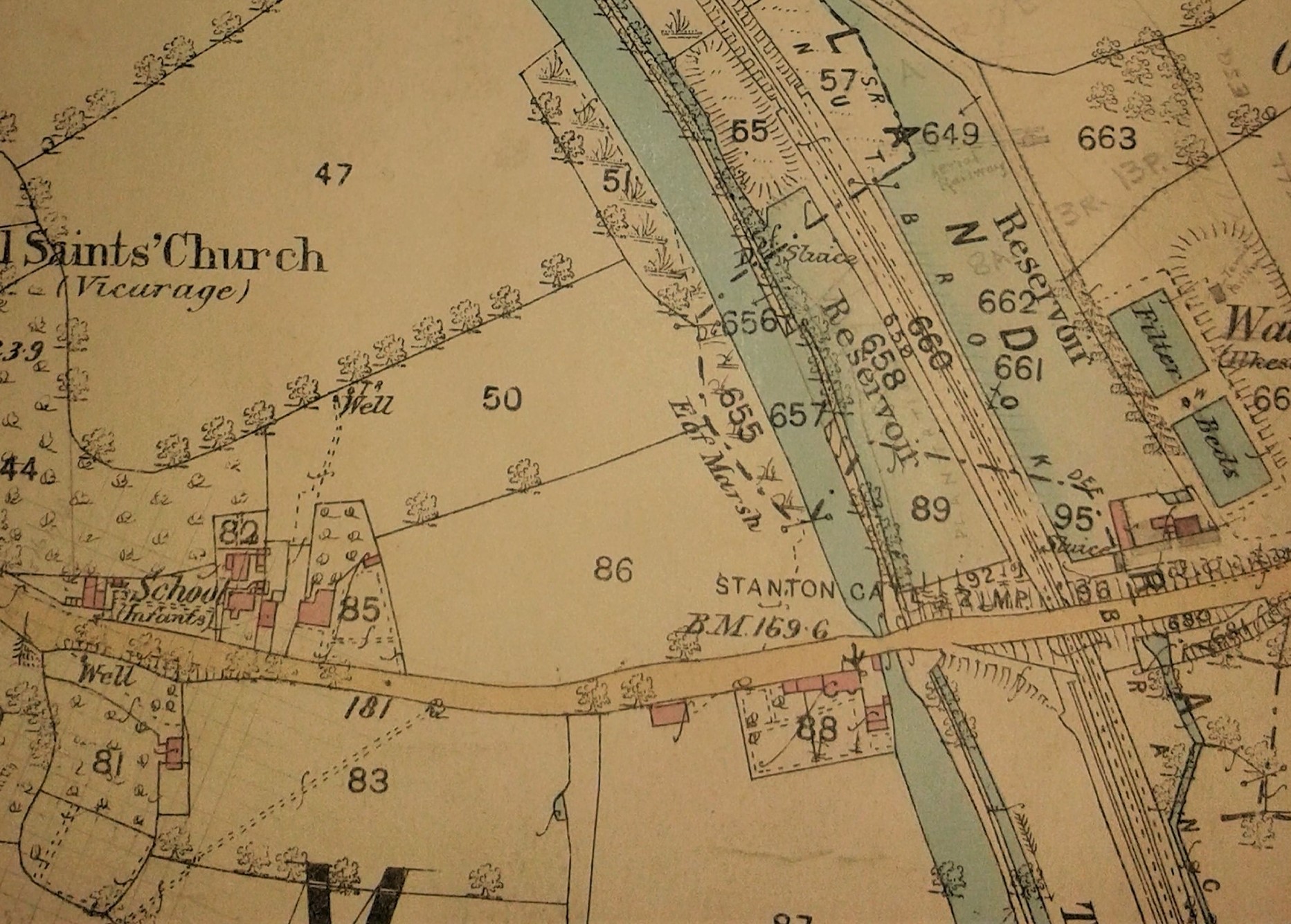
However, six years later, she returned to the Bath Street home of her parents to die there, aged 29, on April 29th, 1881.
Both their children — Eliza Annie and John Potter — had died in infancy in 1880.
And finally in March, 1885, Josph Potter Hardy died in Kirk Hallam, aged 32.
2] Catherine, who married Mr. Northwood.
On January 21st 1883 Catherine (born November 3rd 1853) married widower James Northwood, roll turner at Stanton Ironworks and later butcher of Bath Street, and lived in that street for a time before moving to Poplar’s Farm in Kirk Hallam. Eventually they moved to Nottingham where James continued his trade.
3] John the first died on September 22nd 1855, aged one week, and John the second (born on November 16th 1856) married Hannah Maria Sisson in 1884, she being the daughter of coalminer Ephraim and Ann (nee Smith).
John and Hannah Maria Beardsley had five children, daughter Ida Gwendoline being number 4, born on June 24th, 1892. She is the source of a very interesting series of photos, passed on to me by Jim Beardsley, which I have attached at the foot of this page.
By the end of the century John had inherited the family bakery and brick manufactory and later retired to live at ‘Hildene’ in Longfield Lane, where he died on March 16th, 1940.
Strange folk wot live in Ilson … John Beardsley’s wife had a younger brother, Felix Sisson (born April 13th, 1870) who, as a lad, had spent time at the Basford Workhouse after both his parents had died and before he was six years old.
In March 1891 he found himself at Ilkeston Petty Sessions, charged with assaulting Mary Elizabeth Smith. Felix was under the impression that he was ‘keeping company‘ with the young lady but when she wouldn’t escort him, one evening, he struck her in the face — as you do !!! In a previous encounter he had threatened to put a bullet in her. But Felix had his defence — he had indeed kept company with Mary Elizabeth for over a year but every time she met him in the street she threw slurs at him !!
This was not his first (nor last) encounter with the law, and consequently he was fined 20s with 18/6d costs, or one month with hard labour.
Almost a year later Felix and Mary Elizabeth were married at Ilkeston’s Independent Chapel, and lived the majority of their married life in the Chapel Street area.
Just a few months before his marriage, on December 5th 1891, Felix was in the Bridge Inn, by the Erewash Canal down Awsworth Road, at about 7 o’clock in the evening, when an altercation occurred — in which Felix was involved. He was arguing with George Taylor who, for some reason, offered to wrap the pub’s fire fender around Felix’s neck, at which point the latter decided to leave the Bridge Inn pretty sharply. (It would appear that he was pretty brave when confronted by a woman, but less so when he had to face a man)
Felix ran out of the taproom but only to run into 82-year-old Mary Booth, a widow who resided in Awsworth Road. He tried to avoid her but in his haste, caught her on the shoulder and spun her to the ground. Unaware of this, Felix left her behind, hot-footing it along the canal towpath to the sanctuary of his home in Chapel Street. Only later did he discover what damage he had done.
Felix didn’t look around to see Mary prostrate on the ground, though she was soon rescued by Albert Dawson and 14-year-old Evelyn Barker, son of the Inn’s landlord Emanuel Barker. She was certainly ‘shook up’ and the two escorted her to her nearby home. At that time Mary had a bloody nose but few more visible injuries.
The next day she was visited by her step-son Philip Chell Booth, when she was still in bed, complaining of “ a big fellow” who had knocked her down; “I had done nothing to him”. He noticed a lot of bruising on her arm, two black eyes, a broken nose and lost teeth. She had already been visited by Dr. Robert Wood’s assistants and in the next days it was reported that ‘her health was shattered and she was suffering from great nervous prostration’. Mary died just a week after the accident — from old age and general debility, accelerated by the shock to her nervous system caused by the collision with Felix and the resultant injuries. This was the conclusion of the subsequent inquest jury, which also exonerated Felix.
82-year-old Mary Booth was born Mary Ann Henshaw in Geasley, Nottinghamshire, 1810, the daughter of William and Mary (nee Cook). Her illegitimate son, Richard Henshaw was born on November 30th 1837 (the father was warp-hand John Martin), and Richard died just one year before Mary’s accident. His death had upset her greatly and she had just about recovered from it when she encountered Felix Sisson outside the Bridge Inn. She had married widower Samuel Booth (son of Robert and Alice (nee Chell)) in November 1843 — he had been married to Mary Burrows in 1825 and had at least four children with her; Philip was their youngest. And although his step-mother had been a widow for 21 years, he still visited her regularly from his home in Sheffield.
At the very end of August 1896 Felix was leaving the Nag’s Head in South Street when he found Patrick Rowan waiting for him outside. An affray was subsequently “created” and both found themselves at court. Patrick pleaded guilty to fighting in a public street and was bound over. Felix however disputed the charge — he was only defending himself !! He was given the benefit of the doubt and the case was dismissed.
On October 3rd 1899, just after midnight, Felix and a couple of other men were walking down Providence Place and into Bath Street, being surrepticiously followed by Police Constable Boyle who suspected the group of coming from Shipley. After some undercover spying and careful subterfuge, the P.C. collared Felix and found on his person about a hundred yards of dirty, wet netting, a hare and seven rabbits — now, what could he have been up to ?? When the young man struck out at the policeman he was promptly arrested and jailed for the night.
But Felix had an alibi !! He had got home from work about five pm (he was a coalminer) and afterwards was at the New Inn until about nine. Then he went home and was there until midnight but his wife was ill. As a dutiful husband he walked to Providence Place to get some composition for her from Lebeter’s … and of course wife Mary Elizabeth confirmed his story. The bag of ‘equipment’ and dead animals were planted on him.
Perhaps unsurprisingly this defence didn’t convince the court. In total Felix was relieved of over £3 10s.
4] … and Willie, who died when a young man.
William (born December 10th 1858) left Ilkeston for a time but returned to live with his parents. Working with his brother John as a brick manufacturer he died at the latter’s residence of 7 Bath Street on April 26th, 1899, aged 40, suffering from bronchitis.
William was buried at Park Cemetery on April 31st, after a short service at the Independent Chapel … it was there that William had been an organist for many years.
——————————————————————————————————————–
The other Solomon Beardsleys
There were several Victorian Ilkestonians with the name of Solomon Beardsley — not all born in Victoria’s reign but all surviving to be ruled by her.
1] Solomon, baptised on October 16th 1769, son of stocking weaver Mark and Ann (nee Straw) — a coalminer, he married Mary Gregory on December 31st 1792 and from that time (and before?) he lived at Middle Lane/Road (the Granby Street area) and had at least nine children. His wife died in April 1824, aged 56.
Solomon died on November 12th 1854, aged 89.
2] Born July 24th 1819 — Solomon was the oldest son of Luke and Ann (nee Harrison) and the grandson of Solomon 1. A collier like his father, he married Sarah Ann Phillips on October 14th 1844 — she was the eldest child of coalminer John and Mary (nee Hutchinson).
In 1849 Solomon was employed by coal masters Barber and Walker to work at their pit in Eastwood. On July 31st he was walking along a tunnel down the mine towards his place of work for the day, carrying a lighted candle. As he opened a door to pass through it there was an ignition of flammable gas; Solomon was terribly burned and died three days later.
The proprietors of the pit had invested in air gates and a furnace at the bottom of the shaft, to seal off and draw out the ‘foul air‘, though no designated person had been appointed to attend and take care of the furnace. It appears that the furnace fire had gone out in the days before the accident, the clean air current had stopped and gas had thus built up. The colliers at the pit were not in the habit of using safety lamps unless danger was anticipated.
On New Year’s Day 1851 Solomon’s widow married Matthew Elliott, who was then keeper of the Poplar beerhouse in Bath Street.
3] Born on November 7th 1833 Solomon was the youngest child of miner (coal and stone) Mark and Sarah (nee Trueman) — the grandson of Solomon 1 and the cousin of Solomon 2. He married Hannah Bostock on October 16th 1855 — the daughter of collier John and Hannah (nee Straw).
Nine children later Hannah died at 14 Mundy Street on July 22nd 1871, aged 35 — at that time her eldest child was 15 and her youngest was six months.
Also at that time — living a few doors away from Solomon and his family — was Mary Elizabeth Booth, her parents, her siblings and her illegitimate son Alexander, born on July 30th 1867. Solomon and Mary Elizabeth got together and on September 2nd 1872 married.
Alexander seems to have been ‘adopted’ by his grandparents and lived with them as a son until he married Sarah Jane West of Derby Road in 1890.
By 1880 Solomon had given up mining and was trading as a grocer and beerseller in North Street — and there he stayed until his death, February 15th 1897, at number 65. By that time he had added another six members to the registered ‘Beardsleys’ of Ilkeston.
Solomon left a will dated December 30th, 1891 with a codicil of June 19th 1895. However after the execution of that codicil Solomon destroyed the will, under the mistaken belief that it was no longer required to fulfill his wishes … though he had no wish to revoke the will’s conditions. This act of destruction caused some legal problem after his death, though fortunately a draft will was argued to show his true intentions and this was accepted in the Probate Division in June 1897.
This meant that the property in North Street was left to his widow Mary Elizabeth, she having the right to enjoy it during her lifetime or widowhood. The licence of the beer-off was transferred to her in March 1897. The decision was contested by some of the children but was confirmed in December 1897.
But the matter did not rest there.
Nearly two years later Solomon’s eldest male heir, his son Solomon (see Number 7), who was then living at Sherwood Terrace in Sutton-in-Ashfield, Nottinghamshire, contested the will. He argued that his father had died intestate and so the property should be his as heir-at-law — as he was the sldest son.
However, after a case in the Queen’s Bench Division, the previous judgement was confirmed and once more Mary Elizabeth was free to ‘enjoy’ her life at 65 North Street.
She continued to trade as grocer and beer retailer there and then in Market Street.
She died on October 22nd 1925, aged 79.
During the reign of Queen Victoria (1837-1901) the births of six ‘Solomon Beardsleys’ were registered in the Ilkeston District.
4] Solomon was the son of coalminer Francis and his second wife Mary (nee Goddard) of Workhouse Hill, born about May 1839.
Like many of Ilkeston’s coalminers, Solomon went north to Attercliffe, Sheffield, to work and there he married Ellen Bennett — who was born in Eastwood of Ilkeston parents, William and Maria (nee Smith). The Bennetts had also moved to Attercliffe and on the 1861 census are at Deakin’s Houses there, with Solomon as a lodger.
In April 1864 Solomon and Ellen married in Attercliffe, and remained in Yorkshire for the rest of their lives.
Ellen died on July 2nd 1902 at their home — Addon House in Carter Knowle Road, Sheffield, aged 60.
5] Solomon, born March 11th 1853, was the seventh child of coalminer Elijah and his first wife Ann. She was the daughter of coalminer Samuel Straw and Sarah (nee Leadbetter) and when she died in March 1855, after giving birth to her eighth child, Elijah waited just over a year before he married her younger (by 11 years) sister Sarah … and the couple then had six children.
On October 13th 1872 Solomon married Sarah Ann Knighton, daughter of framework knitter Samuel and Emma (nee Noon) and thereafter lived in the Cotmanhay Road area.
He was the great grandnephew of Solomon 1, and second cousin (once removed) of Solomon 2 and Solomon 3.
6] Born on July 7th 1861, Solomon was the eighth child of coalminer James Beardsley and Ruth (nee Sisson) but he died in 1863.
7] And born on April 14th 1863 was Solomon, son of coalminer Solomon and Hannah (nee Bostock). Working as a coalminer, up until 1911 he lived mostly, but not exclusively, in Ilkeston, unmarried, often lodging with relatives .
I am not sure when he died … perhaps in 1930?
He was the great grandson of Solomon 1, the first cousin once removed of Solomon 2, the son of Solomon 3, the second cousin once removed of Solomon 5 and the first cousin of Solomon 6.
8] The tenth child of James Beardsley and Ruth (nee Sisson), born in 1864 after the death of his brother Solomon, was (thus?) given the name of Solomon — he was baptised at St. Mary’s Church in Ilkeston on October 21st 1866, along with his elder brother Samuel (born between the two Solomons) and younger sister Elizabeth.
He worked as a coalminer, living in the Granby Street area, until, in 1896, he married Mary Ann Smith. She was the daughter of miner John and Elizabeth (nee Hardy), lived at the (Erewash) Canal Side area of Ilkeston and already had two illegitimate children — Percy (born January 12th 1890) and Lily (born April 8th 1894). Both were born at 3 Evans Row … and this is not to be confused with the Evans Row at White Lion Square … this Evans Row was sometimes referred to as the Canal Side or the Potteries, taking its name from Richard Evans, the proprietor of the adjacent Pottery works.
Solomon and Mary Ann then lived in Wentworth Street, just over the Derbyshire-Nottinghamshire border, in Cossall.
On December 22nd 1928, Solomon died at 7 North Street, the home of his (step?) daughter Lily Smith alias Beardsley who had married Phillip Barker in 1924.
Mary Ann died in 1948.
Solomon was the great grandson of Solomon 1, the first cousin once removed of Solomon 2, the nephew of Solomon 3, the 3rd cousin of Solomon 5, the brother of Solomon 6, and the first cousin of Solomon 7.
9] Born in 1877, Solomon was a son of Solomon and Sarah Ann (nee Knighton) and, like his father, worked initially as a coalminer. He married Agnes Morley in 1898 — she was the daughter of William and Eliza (nee Clower).
Did he move to Doncaster where he died in 1938, aged 60 ?
Is this him ? .. appearing at the Borough Court in Doncaster, November 1923. ‘Solomon Beardsley, an ex-miner of Balby was fined 30s for street betting. He promised to give the practice up and was told by the Magistrates that it was not a paying game and was no good to him’.
He was the great great grandnephew of Solomon 1, the second cousin twice removed of Solomon 2 and Solomon 3, the son of Solomon 5, the third cousin once removed of Solomon 6 and Solomon 8, and the third cousin of Solomon 7.
Baker Solomon of Bath Street was the grandson of Solomon 1, the first cousin of Solomon 2 and 3, second cousin once removed of Solomon 5, first cousin once removed of Solomon 6, 7 and 8, and second cousin twice removed of Solomon 9.
——————————————————————————————————————————————
Post script . the photo album of Ida Gwendoline Beardsley
Jim Beardsley writes (August 11th 2020) ….
I have been contacted by an American, Tricia Culbertson, with a number of photos of the Beardsley and Donson families, Sadly only one has a name.
Tricia’s mother was Jean Molly Donson, born 1925, who married Lawrence Francis Murray, an American serviceman, in 1945, while he was stationed at Wollaton Hall. A few years later they left for America. Molly’s parents were Arthur Donson, born 1893, and Ida Gwendoline Beardsley, born 1892. They were living at 1 Regent Street in 1939.
Ida Gwendoline’s parents were John Beardsley (1856-1940) and Hannah Maria Sisson (1866-1928) … the one photo with a name is that of John (below), who just like his father Solomon, was a long-established baker and confectioner of Bath Street.
The remaining photos are displayed below, and some of them are of poor quality.
The final photograph (below) is an interesting one …. and knowing very little of military history I enlisted the help of members of the Ilkeston and District Local History Society (Facebook Page) to help identify the uniform. Alison, Julie and Tim were really helpful — my many thanks to them — I have included their thoughts alongside the photo.
——————————————————————————————————————————————————–
And here is the second selection of Beardsley photos, forwarded by Jim (September 1st 2020)
I appreciate that this is a long shot, and that the quality and clarity of some of the photos are challenging, … but if anyone has any ideas about them, please let me know.
Or if you can see a connection between any of the photos ?
Then came the Scattergood’s shop. The Grand Tour.

